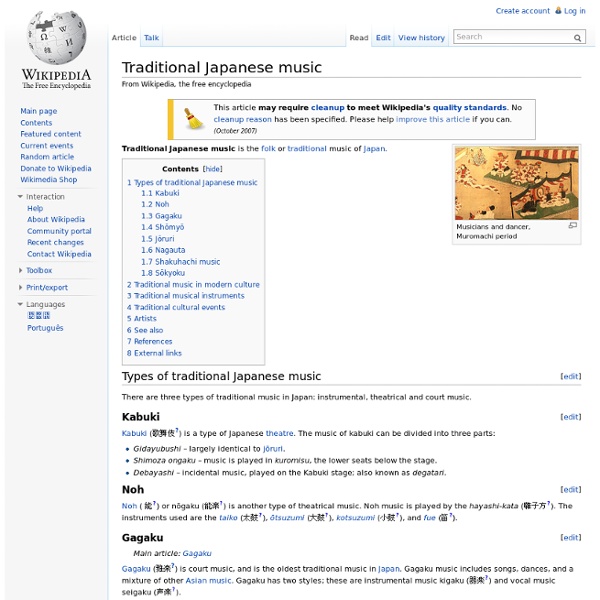Music of China
Chinese music refers to the music of the Chinese people, which may be the music of the Han Chinese as well as other ethnic minorities within mainland China. It also includes those music produced by people of Chinese origin outside of mainland China using traditional Chinese instruments or in the Chinese language. Different types of music have been recorded in historical Chinese documents from the early periods of Chinese civilization which, together with archaeological artifacts discovered, provided evidence of a well-developed musical culture as early as the Zhou Dynasty (1122 BC – 256 BC). These further developed into various forms of music through succeeding dynasties, producing the rich heritage of music that is part of the Chinese cultural landscape today. Chinese music however continues to evolve in the modern times, and more contemporary forms have also emerged. History[edit] Early history[edit] Chinese philosophers took varying approaches to music. Current[edit] National music[edit]
Celtic music
Celtic music is a broad grouping of musical genres that evolved out of the folk musical traditions of the Celtic people of Western Europe.[1][2] It refers to both orally-transmitted traditional music and recorded music and the styles vary considerably to include everything from "trad" (traditional) music to a wide range of hybrids. Often the melodic line moves up and down the primary chords in so many songs. There are a number of possible reasons for this: Melodic variation can be easily introduced. These two latter usage patterns may simply be remnants of formerly widespread melodic practices. Often, the term Celtic music is applied to the music of Ireland and Scotland because both lands have produced well-known distinctive styles which actually have genuine commonality and clear mutual influences. The definition is further complicated by the fact that Irish independence has allowed Ireland to promote 'Celtic' music as a specifically Irish product. Divisions[edit] Forms[edit]
Folk music
Folk music includes both traditional music and the genre that evolved from it during the 20th century folk revival. The term originated in the 19th century but is often applied to music that is older than that. Some types of folk music are also called world music. Traditional folk music has been defined in several ways: as music transmitted by mouth, as music of the lower classes, and as music with unknown composers. It has been contrasted with commercial and classical styles. One meaning often given is that of old songs, with no known composers; another is music that has been transmitted and evolved by a process of oral transmission or performed by custom over a long period of time. Starting in the mid-20th century a new form of popular folk music evolved from traditional folk music. Traditional folk music[edit] Definitions[edit] A consistent definition of traditional folk music is elusive. Such definitions depend upon "(cultural) processes rather than abstract musical types Tune[edit]
Music of Southeastern Europe
The music of Southeastern Europe or Balkan music is a type of music distinct from others in Europe. This is definitely because it was influenced by traditional music of Southeastern European ethnic groups and mutual music influences of these ethnic groups. The music is characterised by complex rhythm. The music of the Slavic countries of Southeastern Europe is significantly different from the music of Eastern Europe, which includes the Slavic states of the former USSR. The latter was much more influenced by the common eastern Slavic culture, notably by Kievan Rus and more recently the USSR. Neighboring musical influences[edit] Byzantine medieval music[edit] Main articles: Byzantine music Byzantine (Greek: Βυζαντινή Μουσική), traditional music is associated with the medieval sacred chant of Christian Churches following the Constantinopolitan rite. Greek music[edit] Main articles: Greek music Greek folk music includes Demotika, Cretan and Nisiotika, Pontian, Laiko and Rebetiko. Albania[edit]
Pagan-Folk
Pagan-Folk (eng. pagan, heidnisch) ist eine Richtung der Folk-Musik mit Elementen aus dem Neopaganismus, die sich Ende der 1990er Jahre zum Teil aus der Musik der Mittelalterszene heraus entwickelte. Stil[Bearbeiten] Vertreter und Veranstaltungen[Bearbeiten] Siehe auch[Bearbeiten] Neofolk Weblinks[Bearbeiten] Stéphane François: Paganmusik in Europa (englisch; MS Word; 104 kB) Politikwissenschaftlerin Einzelnachweise[Bearbeiten] Hochspringen ↑ beltaine-festivals.de
Music of Ireland
The bodhrán, a traditional Irish drum. Irish Music is music that has been created in various genres on the island of Ireland. The indigenous music of the island is termed Irish traditional music. It has remained vibrant through the 20th, and into the 21st century, despite globalizing cultural forces. In spite of emigration and a well-developed connection to music influences from Britain and the United States, Irish music has kept many of its traditional aspects and has itself influenced many forms of music, such as country and roots music in the USA, which in turn have had some influence on modern rock music. Early Irish music[edit] By the High and Late Medieval Era, the Irish annals were listing native musicians, such as the following: Modern interpretation[edit] Early Irish poetry and song has been translated into modern Irish and English by notable Irish poets, song collectors and musicians. Early Irish musicians abroad[edit] Some musicians were acclaimed in places beyond Ireland.




Skip down to Joruri and Nagauta by hassmanb Nov 30